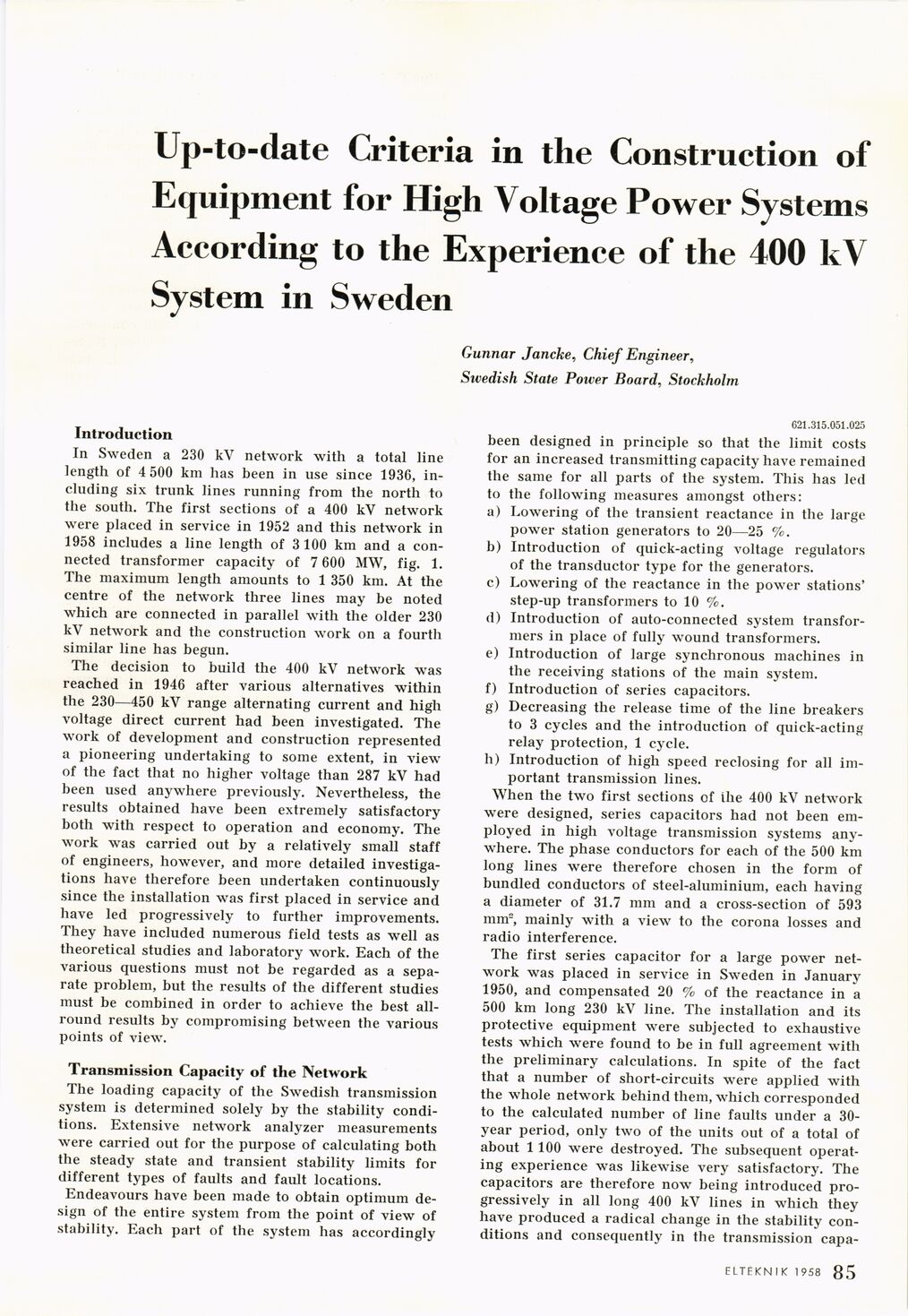
Full resolution (JPEG) - On this page / på denna sida - 1958, H. 6 - Up-to-date Criteria in the Construction of Equipment for High Voltage Power Systems According to the Experience of the 400 kV System in Sweden, by Gunnar Jancke

<< prev. page << föreg. sida << >> nästa sida >> next page >>
Below is the raw OCR text
from the above scanned image.
Do you see an error? Proofread the page now!
Här nedan syns maskintolkade texten från faksimilbilden ovan.
Ser du något fel? Korrekturläs sidan nu!
This page has never been proofread. / Denna sida har aldrig korrekturlästs.
Up -to-date Criteria in the Construction of
Equipment for High Voltage Power Systems
According to the Experience of the 400 kV
System in Sweden
Gunnar Jancke, Chief Engineer,
Swedish State Power Board, Stockholm
621.315.051.025
Introduction
In Sweden a 230 kV network with a total line
length of 4 500 km has been in use since 1936,
including six trunk lines running from the north to
the south. The first sections of a 400 kV network
were placed in service in 1952 and this network in
1958 includes a line length of 3100 km and a
connected transformer capacity of 7 600 MW, fig. 1.
The maximum length amounts to 1 350 km. At the
centre of the network three lines may be noted
which are connected in parallel with the older 230
kV network and the construction work on a fourth
similar line has begun.
The decision to build the 400 kV network was
reached in 1946 after various alternatives within
the 230—450 kV range alternating current and high
voltage direct current had been investigated. The
work of development and construction represented
a pioneering undertaking to some extent, in view
of the fact that no higher voltage than 287 kV had
been used anywhere previously. Nevertheless, the
results obtained have been extremely satisfactory
both with respect to operation and economy. The
work was carried out by a relatively small staff
of engineers, however, and more detailed
investigations have therefore been undertaken continuously
since the installation was first placed in service and
have led progressively to further improvements.
They have included numerous field tests as well as
theoretical studies and laboratory work. Each of the
various questions must not be regarded as a
separate problem, but the results of the different studies
must be combined in order to achieve the best
all-round results by compromising between the various
points of view.
Transmission Capacity of the Network
The loading capacity of the Swedish transmission
system is determined solely by the stability
conditions. Extensive network analyzer measurements
were carried out for the purpose of calculating both
the steady state and transient stability limits for
different types of faults and fault locations.
Endeavours have been made to obtain optimum
design of the entire system from the point of view of
stability. Each part of the system has accordingly
been designed in principle so that the limit costs
for an increased transmitting capacity have remained
the same for all parts of the system. This has led
to the following measures amongst others:
a) Lowering of the transient reactance in the large
power station generators to 20—25 %.
b) Introduction of quick-acting voltage regulators
of the transductor type for the generators.
c) Lowering of the reactance in the power stations’
step-up transformers to 10 %.
d) Introduction of auto-connected system
transformers in place of fully wound transformers.
e) Introduction of large synchronous machines in
the receiving stations of the main system.
f) Introduction of series capacitors.
g) Decreasing the release time of the line breakers
to 3 cycles and the introduction of quick-acting
relay protection, 1 cycle.
h) Introduction of high speed reclosing for all
important transmission lines.
When the two first sections of llie 400 kV network
were designed, series capacitors had not been
employed in high voltage transmission systems
anywhere. The phase conductors for each of the 500 km
long lines were therefore chosen in the form of
bundled conductors of steel-aluminium, each having
a diameter of 31.7 mm and a cross-section of 593
mm2, mainly with a view to the corona losses and
radio interference.
The first series capacitor for a large power
network was placed in service in Sweden in January
1950, and compensated 20 % of the reactance in a
500 km long 230 kV line. The installation and its
protective equipment were subjected to exhaustive
tests which were found to be in full agreement with
the preliminary calculations. In spite of the fact
that a number of short-circuits were applied with
the whole network behind them, which corresponded
to the calculated number of line faults under a
30-year period, only two of the units out of a total of
about 1 100 were destroyed. The subsequent
operating experience was likewise very satisfactory. The
capacitors are therefore now being introduced
progressively in all long 400 kV lines in which they
have produced a radical change in the stability
conditions and consequently in the transmission capa-
ELTEKN I K 1958 7 ]
<< prev. page << föreg. sida << >> nästa sida >> next page >>